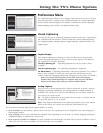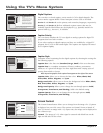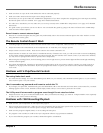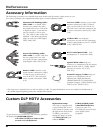
References
Chapter 5 79
If you’ve connected a component to your A/V receiver, such as a DVD player or satellite receiver, you may experience a slight delay
between the audio heard and the video seen. This occurs because the digital audio is sent directly to the speakers while the video
must be processed inside the TV before it is displayed.
• If the component has Component Video (Y, Pb, Pr) jacks, connect these jacks to the TV’s Y, Pb, Pr jacks to minimize the
discrepancy. This works best if the component supports Progressive Scan technology.
• If necessary, you can connect the component directly to the TV using L/R audio jacks and bypassing the A/V receiver or you can
program an audio delay in the A/V receiver so the audio and video match up (not all audio equipment has the ability to program
delays). Check the Audio/Video Receiver’s manual.
Blank screen
• Make sure you have connected the component to the TV correctly.
• Make sure the component connected to the TV is turned on and tuned to the corresponding Video Input Channel.
•Try another channel.
• When you first turn off TV, the screen fades from blue to black. Once the screen goes black, the TV’s internal lamp starts its cool-
down cycle. If you try to turn on the TV during the cool-down cycle, the power light on the front of the TV will blink to alert you
that you need to wait (when the cool-down cycle is complete—about 30 seconds—the TV turns back on automatically).
• If you’re trying to tune to a digital (ATSC) channel that you know exists, you may need to disable the Digital Channel Info. Go to the
Main Menu (press MENU); choose Preferences (press 7); choose Digital Channel Info (press 8). If you’re using the TV’s Web
Browser, it times out automatically when idle for a period of time.
• If you’re trying to play a 1394 Recording, you may have accessed an “unrecorded” subchannel. Press the CH+ or CH- buttons to go
through the subchannels before you get to the subchannel you recorded. This occurs even when you’ve selected to record only a
specific subchannel because of how digital (ATSC) channels are broadcast and recorded by your 1394 device—the data for the
subchannel is recorded, but not the content.
Unusual sound quality
• Check the Graphic Equalizer, SRS, and Sound Logic settings.
Humming or buzzing noise
• The TV is in its lamp cool-down cycle. To prolong the life of the TV’s lamp system, the TV must warm up and cool down properly.
You may notice additional noise during these cycles.
• Maybe the speakers are turned off. Check the FIXED/VARIABLE OUT control panel in the Audio menu.
No picture, sound okay
• If the indicator on the front of the TV is blinking, the lamp inside of your TV may need to be changed. Go to page 84 for ordering
information.
No sound, picture okay
• Maybe the sound is muted. Try pressing the volume up button to restore sound.
• Maybe the speakers are turned off in the Audio menu. Check the FIXED/VARIABLE OUT control panel in the Audio menu.
• If using an S-Video connection, DVI-HDTV, component video and composite video, remember to also connect the component’s L
and R AUDIO OUT jacks to the TV’s L and R INPUT jacks.
• Check the position of the INT W/EXT SURR and EXT switch on the back of the TV.
• Make sure the correct Audio Processor mode (Mono, Stereo, SRS, SRS FOCUS and SRS TruSurround XT) is selected.
Can’t select certain channel
• May be blocked or not approved in the Parental Controls menu.
• If using a VCR, check to make sure the TV/VCR button on the VCR is in the correct mode (press the TV/VCR button on your VCR).
•You can’t change channels when a menu is on the screen (press the CLEAR button).
Noisy stereo reception
• May be a weak station. Use Audio menu to choose Mono sound.


















